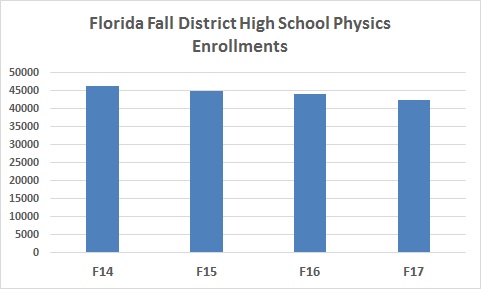New data on Fall 2017 class enrollments supplied by the Florida Department of Education reveal that physics enrollments in Florida’s district high schools continued to decline for a third consecutive year. This fall, enrollments were 3% lower than a year ago, and they are now 8% lower than they were in Fall 2014.
The FLDOE says the enrollment numbers are preliminary and subject to updating.
The enrollment numbers include traditional district high schools, charter high schools, and district-affiliated virtual schools. The numbers do not include dual enrollment, which FLDOE no longer reports.
Physics is the gateway high school science course for college majors such as engineering, computer science, chemistry and physics. College majors in life and health sciences require physics, and students are significantly more likely to perform well in college physics if they take a physics course in high school.

A survey of state departments of education (plus DC) performed in the summer of 2015 showed that Florida was already in the lower tier of states for physics enrollment rate.

Much of the decline in total physics enrollment over the last three years came from the sharp downward trend in enrollments in the non-Honors Physics 1 course. Enrollments in AP Physics 1, which was designed to replace the traditional Honors Physics 1 course, continue to be disappointingly low.
For the 2017-18 school year, the Florida State Board of Education removed “Physical Science”, which includes both chemistry and physics, from the list of Critical Teacher Shortage Areas.

Pingback: Florida must prepare its children to compete for leadership roles in our technological economy – a response to an Orlando Sentinel op-ed | Bridge to Tomorrow
Pingback: Are parents’ and students’ college admission fears driving down high school physics enrollments? | Bridge to Tomorrow
Pingback: To reverse Florida’s decline in high school physics, college and university faculty should step up | Bridge to Tomorrow
Pingback: Chemistry enrollments in Florida’s district high schools have dropped 9% in two years | Bridge to Tomorrow
Pingback: Access to high school physics in Florida: 32 public high schools with 1,000 or more students do not offer physics | Bridge to Tomorrow
Pingback: Florida’s university physics departments should prepare for a future of increasingly unprepared students | Bridge to Tomorrow
Pingback: Is the Florida “teaching gap” narrowing, as Miami Today reported? Not in math and science. | Bridge to Tomorrow
Pingback: As the new school year begins, where are Florida’s bright spots for STEM career preparation? | Bridge to Tomorrow
Pingback: Is Florida doing STEM yet? CareerSource Florida says “yes!” I’m not so sure. | Bridge to Tomorrow
Pingback: In high school physics classrooms, modern lab equipment demonstrates commitment by school and district leadership to improving STEM readiness | Bridge to Tomorrow
Pingback: Dual enrollment, early college, and the engineering and physics pipelines: A map of the eight years from 9th grade to bachelor’s degree | Bridge to Tomorrow
Pingback: FSU’s DFW rate metric: What I told my Physics Department colleagues | Bridge to Tomorrow
Pingback: Sure there is good news about Florida’s schools. But there is bad news, too – about how poorly the state prepares its students for college STEM majors. | Bridge to Tomorrow
Pingback: Will Florida’s charter schools help improve the preparation of the state’s high school students for college STEM majors? | Bridge to Tomorrow
Pingback: Parents play a key role in preparing their high school students for college STEM majors. Is that message getting to Florida’s parents? Mostly not. | Bridge to Tomorrow
Pingback: Bachelors’ degrees in engineering, computer science and physics are among the surest routes to economic security in America and more Florida students should have access to them: What I’ll be doing in 2019. | Bridge to Tomorrow
Pingback: Coercion is no substitute for persuasion: As difficult and slow as it is, persuading parents, teachers, counselors, administrators and policy-makers to improve the preparation of high school students for college STEM majors is the only way to make lasting